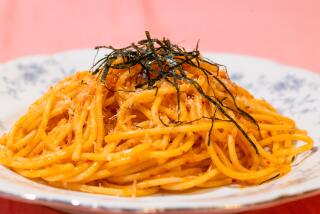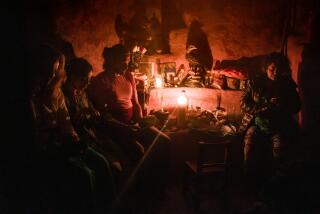Best Uses for Dried Mushrooms
Question: I would be thrilled with an answer to this one. My sister-in-law gave me a jar of dried mushrooms. I am an experienced cook, but I’m stumped as how to use these. Do I use them in casseroles? Also, do they have to be washed? And do they need to be reconstituted in water before adding to a recipe? I’d appreciate any suggestions you can offer.
Answer: Since you didn’t mention the type of mushrooms you received, we’re providing information on dried Chinese black, Japanese shiitake, French cepes and Italian porcini mushrooms as well as morels. The following is excerpted from “The Von Welanetz Guide to Ethnic Ingredients” by Diana and Paul Von Welanetz (Warner Books: 1982).
CHINESE BLACK OR WINTER MUSHROOMS
There are several varieties of Chinese dried mushrooms, and it is not always easy to tell the difference between them. Winter (or black) mushrooms are large with rather flat caps; the Northern have rounder, speckled caps. As a general rule, the larger, light-colored ones are the most tender and flavorful.
PREPARATION AND USE: All dried mushrooms require soaking to bring them back to their original shape. The first step is to rinse them very well in cold water to remove any sand. They can be soaked in hot water or stock for 30 to 90 minutes, depending on their size. (Some cooks prefer to soak them 8 hours or longer in cold water, saying they retain more flavor with this method.) Squeeze out excess moisture from the soaked mushrooms and cut away the woody stems before using.
Usually the soaking liquid, minus any grit, is used in the recipe for additional flavor. Save the stems and soaking liquid (if not otherwise used) to add flavor to stocks.
Small mushrooms generally are cooked whole; large ones are shredded. They can be braised or simmered, or added to stir-fry dishes or soups.
SHIITAKE
The Japanese shiitake is the most popular dried mushroom used in Oriental cooking.
PREPARATION AND USE: Shiitake mushrooms are generally very clean and need only a brief rinsing. They should be soaked in hot water or stock for 10 to 60 minutes, depending on their size. Squeeze out excess moisture from the soaked mushrooms and cut away the woody stem before using.
Small shiitake are generally cooked whole; large ones are shredded. They can be braised or simmered, or added to stir-fry dishes or soups.
CEPES OR PORCINI
These provide a superb woodsy flavor and aroma to stuffings, soups and sauces. In Provence, France, they are sauteed in olive oil and then topped with chopped onion, garlic and bread crumbs just before serving. They are used in souffles, quiches and all manner of creamy sauces.
PREPARATION AND USE: Soak these in very hot water for about 20 minutes until softened; squeeze and rinse. Strain the soaking liquid through several layers of fine cloth to rid it of sand.
MORELS
Morels have tall conical caps rather than flat or dome-shaped tops and are crinkly in appearance, like accordions.
PREPARATION AND USE: Soak them for 20 minutes in boiling water, rinse well and cut in half lengthwise. Wash them several times and soak the morels again in warm water to allow any remaining sand to fall out. Lift carefully, rinse again, and they’re ready to use.
They are usually added to a sauce just before it is finished, so the mushrooms are only warmed through.
They are strong in flavor and can be used in combination with cultivated mushrooms to add a depth of flavor to many dishes. They can be used in all recipes that call for cepe mushrooms. They are often used as a flavoring in soups, sauces, potatoes and scrambled eggs.
Thank you to the many readers who responded after the Nov. 19 You Asked About . . . column asking where to find acini di pepe. It’s a tiny pasta product, available in most Italian grocery stores and some supermarkets.


